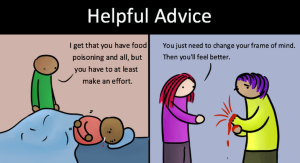As a kid, I secretly loved to dress up in my sister’s dresses and wear makeup, and even though I pretended to hate it, I loved playing Barbies. In time, though, bullying and intimidation taught me how I was “supposed to act.”
By high school, I tried to exude the stereotypes of what a man is supposed to be: I acted like a tough guy (once punching my best friend and nearly ruining a friendship simply because I didn’t want to show emotional vulnerability), and I constantly expressed toxic heteronormativity, objectifying and treating women like garbage.
Once I got to college, though, two important things changed the way I think about masculinity and my relationship to it.
First, women in my life shared with me the ways they’d been directly hurt by toxic masculinity though sexual violence. Second, male mentors in my life reached out to me and helped me understand different ways of being a man.
These revelations were important for helping me find a path toward cultivating a different kind of masculinity. And it’s important for me to think of this as a path – because I’m still very much traveling in the direction of healthier masculinity while often losing my way, screwing up, and needing to do better moving forward.
As I reflect on my own learning, though, it’s notable that it took leaving my home environment and immersing myself in different ways of thinking to shift my reality.
This isn’t true for every man who embarks on the path toward healthier masculinity, but for those men who go to college, we find a unique opportunity to engage men.
Hence, “men’s work” and male-engagement programming are becoming more and more common on college campuses. Full-time positions are being created to focus on men’s engagement in creating positive community and ending sexual violence, and some schools are going as far as to create Men’s Centers (more on that later).
Unfortunately, though, while men’s engagement programs and positions offer unique opportunities for reducing sexual violence and promoting healthier ways of being men, there are a lot of dangers and pitfalls in doing this work as well.
As a result, I’ve compiled five dangers to consider and four suggestions for effectively engaging men on college campuses in hopes of offering some important considerations for students and professionals on college and university campuses who are taking up “men’s work.”
1. Men’s Work Lacking Intersectional Anti-Oppression Analysis Reinforces Oppression
Probably the single most significant issue with work on men and masculinities is also somewhat of an umbrella for the other four dangers: When we do men’s work without careful attention to intersectional feminism, we can recreate the very problems we’re working against.
A perfect example of this is the movement to create “Men’s Centers” on college campuses because of declines in net enrollment among men.
It’s notable that the cesspool of Men’s Rights Activism known as A Voice for Men has published content lauding the movement to create more “Men’s Centers” on college campuses. Historically, identity-based centers have been spaces for marginalized and oppressed people to find community and safe space in otherwise hostile college environments. But men are neither oppressed nor marginalized for their gender on college campuses.
Yet many of the campuses who see a need for men’s centers cite “the disappearing male on college campuses,” where “there are over 31% more women on campus than men.”
The problem, though, is that the “lack of men on college campuses” is less about gender than it is about the intersection of race and gender.
The percentage of young White men going to college has not changed since 1994, but the rates of attendance for Black, Latino, and Indigenous men have decreased significantly. If we refuse to disaggregate the data, it’s impossible to recognize that men of Color are in need of particular support in higher education, but men, in general, may not be.
Further, the generalized men’s work focus can also treat issues of toxic masculinity as problems of individual men if we aren’t considering them through wider anti-oppression lenses that take heterosexism, racism, cissexism, and sexism and misogyny into account.
Effective men’s work means engaging the systems of gender oppression and their relationships to other forms of oppression as part of our analysis and our work.
Thus, men’s programming that isn’t being responsive to the realities of power and oppression can end up reifying oppression and leaving out those people who most need support in navigating what it means to express healthy masculinity while succeeding in the college environment.
2. Men’s Work Often Relies on Problematic Gender Essentialism
There is a strand of “men’s work” that grounds analysis of toxic masculinity in a call to “reclaim” imagined notions of masculinity from “days long passed.”
Though it’s more common among new-age “progressives” than on college campuses, it does show up in the analysis of some who work with men’s groups around the United States.
Throwing around phrases like “the sacred masculine” and “tapping our primal energies” (again, there’s a whole article on a popular MRA website to which I won’t link), this branch of men’s work relies on outdated notions of “masculine and feminine” that don’t take into consideration the social construction of gender.
Not only is this language problematic for people who don’t fit into the gender binary, but it’s closely tied to the same essentialist arguments that have been used for ages to excuse men’s sexual violence (a la “Men are animals and can’t help but rape”).
Additionally, this “primal masculine energy” talk tends to lend itself to the appropriation of Indigenous cultures, with workshops calling on men to attend sweat lodge ceremonies and align their energy with the equivalent of a sprit animal.
3. Men’s Work Can Provide Cover for Abusive Men
In his brilliant article “Engaging Men in Men’s Violence Prevention,” Bob Pease notes that “we must be careful…not to assume that men who speak out against other men’s violence are necessarily free from violence in their own lives.”
There are ways that all men (including myself) can and do participate in violence against women, even if in subtle forms like in the language we use or how we argue with our female partners.
Further, there is a long and, frankly, disgusting history of predatory men positioning themselves in feminist movements to perpetrate abuse under the cover of “But I’m a feminist!”
Thus, if we’re going to take up “men’s work” on our campuses, it must not only be in the context of explicit anti-violence framing, but it must demand that we listen to women about the men in our midst and hold one another accountable.
4. Men’s Work Can Shift the Focus of Feminist Work Away from Women
Inevitably focusing on men means turning our focus away from women or those who don’t fit into the binary, and to a certain degree, that’s fine. But there is also a danger, again highlighted well by Bob Pease, that men’s work will distort the real issues being tackled by feminism.
If the focus becomes “men’s alienation” with any analysis rooted in feminist and women’s leadership, it serves to reify male power and privilege, as it doesn’t acknowledge the context of power and oppression in which that alienation takes place.
As is often repeated, yes, men in the modern age are often feeling lost and alienated, but the root of that alienation must be understood as existing within patriarchy, or we slide down the slippery slope into the men’s rights movement.
Thus, even if it’s true that men more and more feel alienated from that privilege and power, that doesn’t make male privilege and power any less real in our society, and our men’s work must be clear to address this from a feminist framework led by women as well as Trans and non-binary folks.
5. Men’s Work Without Accountability Damages Trust – And Wider Movements
Many feminist women have a healthy and well-placed mistrust of “feminist men” (see #2), which not only makes accountable collaboration more difficult. But it can also damage wider movements by fraying community and trust.
Thus, it is important that men’s work must be done with a spirit of clear accountability.
Hence…
4 Suggestions for Effective Men’s Work
1. Create Formal Accountability Structures and Procedures
This is definitely one that I need to take up in my own work, but structures of accountability are important for those with privilege in social justice movements.
Accountability ensures not only that the work we’re doing is in alignment with those who don’t share our identity, but also that we don’t shelter ourselves from criticism in making mistakes or hurting others.
It’s also important that this accountability is rooted in feminist values and analysis.
Though it applies to White people in racial justice work, a good example of a formal accountability structure can be found in Showing Up for Racial Justice.
2. Cultivate a Dual Focus on Inclusive Spaces and Outreach
Let’s face it – not all programming that we might take up can or should serve a “one-size-fits-all” function. We need our work to both call in men who are exemplifying toxic masculinity and to create space for transformative, inclusive masculinity to thrive.
With regard to the former, we must be clear – Saida Grundy was spot-on when she named White men as “the problem population” on US college campuses (at least at predominantly White institutions).
Who is committing the vast majority of sexual violence? Men. And outside of HBCUs and a few other campuses around the country, White men are nearly always the majority of males. Who is most likely to be sanctioned for excessive alcohol consumption or destruction of property? Men – and most often, White men.
So we need programming designed to reach the “bros” on our campuses, and we need to find creative ways to address vital topics in masculinity and violence.
At the same time, though, such topics can wholly exclude Queer and Transgender men and many men of Color, so we need to create spaces for discussing masculinity that center marginalized identities.
What are we doing to center men of Color at White institutions? To center Trans and Gender Non-Conforming people who are masculine of center? To create spaces where men can actually explore alternative expressions of masculinity without ridicule from peers? We need programs that effectively answer these questions.
3. Create Opportunities for Men to Have Positive Impacts on Their Peers
Simply put, men have profound impacts on their peers’ attitudes about violence against women, homophobia, and masculinity.
So if we want to encourage young men to create healthier, more inclusive, and less violent ways of being men, we need men to work with peers toward these ends.
It’s important, then, that we recruit a diversity of young men who can take up the work of influencing their peers (whether through mentoring programs, fraternity structure, workshops, or other mediums).
When male relationships are grounded in anti-oppression values and encourage men to hold one another accountable toward these values, we can see serious shifts in attitudes and behaviors.
4. Broaden the Lens of ‘Bystander Intervention’
There are many important critiques of bystander intervention programs as a tool for changing male behavior or ending sexual violence.
Some point to the dangers of implicit bias, whereby Black or Brown men would be more likely identified as “dangerous” than White men. Others note that bystander intervention exposes those intervening to violence themselves. Still others note that when sexual violence regularly happens in intimate spaces where victims otherwise might have felt safe, it’s not a strategy that can be relied upon.
That said, there is also research that bystander intervention training can have lasting impacts on the attitudes of those involved, and it has been found effective in positively changing male attitudes and behaviors.
So in the context of men’s work, perhaps it’s best to think of bystander intervention more broadly, training men to speak out against language and behavior that degrades and objectifies women mocks and trivializes rape can be an important tool in changing men’s wider behavior.
If we only think of bystander intervention through the lens of stopping someone in the midst of rape or predatory behavior, it’s perhaps less effective, but if we think about it in the wider sense of challenging social norms and common male attitudes and behaviors, we’re likely to see more success.
***
Though toxic masculinity shows up in myriad forms in our lives, one of the most obvious and destructive is violence.
Men commit most violence. Period.
So we need to remember: Men’s silence perpetuates men’s violence.
Homophobic violence, misogynistic violence, racist violence, or men’s interpersonal violence – these are our problems to solve.
When we engage more men in transforming what it means to be a man by realizing healthier, more fulfilling masculine identities, we open the door not only to transformation of our relationships with those who don’t share our identity but with other men.
Thus, despite the dangers and pitfalls, men have a responsibility to work with other men to transform our relationships and identities.
And for those of us working in the collegiate context, we have a responsibility to take advantage of the unique opportunities offered by the college environment to engage men in intersectional, accountable, feminist men’s work.
[do_widget id=’text-101′]
Jamie Utt is a Contributing Writer for Everyday Feminism. He is the Founder and Director of Education at CivilSchools, a comprehensive bullying prevention program, a diversity and inclusion consultant, and sexual violence prevention educator based in Tucson, AZ. He is currently working toward his PhD in Teaching, Learning, and Sociocultural Studies at the University of Arizona with research interests in the role that White teacher’s racial identity plays in their teaching practice. Learn more about his work at his website here and follow him on Twitter @utt_jamie. Read his articles here and book him for speaking engagements.
Search our 3000+ articles!
Read our articles about:
Our online racial justice training
Used by hundreds of universities, non-profits, and businesses.
Click to learn more





















